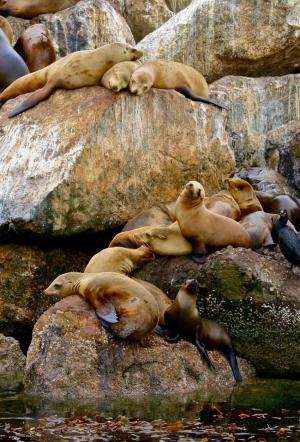Mussels on California Coast contaminated with giardia transmitted from land-based sources

The pathogen Giardia duodenalis is present in mussels from freshwater run-off sites and from areas where California Sea Lions lounge along the coast of California, according to a team of researchers from the University of California, Davis. One of the G. duodenalis strains found is known to infect humans; the two others occur mostly in dogs and other canids. "Thus, the detection of these assemblages implies a potential public health risk if consuming fecally contaminated water or uncooked shellfish," says coauthor Woutrina Smith. The research is published ahead of print in Applied and Environmental Microbiology.
In the study, the investigators collected sea lion fecal samples and mussels from the ocean near the mouths of rivers, as well as from the shore near sea lion haul-out sites along the central coast of California. They used polymerase chain reaction (PCR) followed by DNA sequence analysis to investigate whether the pathogens were present. PCR is a method for "amplifying DNA," by making large numbers of copies of it.
"Our hypothesis was that if pathogen pollution was flowing from land to sea, then the same genotypes of these protozoan parasites, Cryptosporidium and Giardia, found in terrestrial animals would be found in mussels, which are normally found at run-off and sea lion haul-out sites, and in the feces of California Sea Lions," says first author Aiko Adell.
The investigators collected mussels not simply to see if they were carriers of the pathogens, but as an ingenious research strategy. As filter feeders that process large quantities of water—2 liters per hour—shellfish concentrate pathogens very effectively. "Testing the mussels enabled us to more quickly find the pathogens, rather like using a magnet to find needles in a haystack, instead of sifting through all that straw," says coauthor Patricia Conrad.
The investigators detected oocysts and cysts in sea lion fecal samples that were similar in appearance to those of both Cryptosporidia and Giardia, as examined using fluorescent microscopy, but they were unable to detect the relevant DNA via PCR, likely due to the low numbers of parasites present, says Smith.
The story is different in the mussels, in which no oocytes or cysts were detected, but the researchers did detect DNA from Giardia in a small number of mussel hemolymph samples. "Our research reaffirms the usefulness of testing filter-feeding shellfish that can concentrate protozoan parasites and other pathogens in aquatic environments," says Smith. "The use of filter-feeding shellfish helps overcome dilution limitations of direct water testing, and the difficulties of detecting positive fecal samples in the field because fecal shedding of oocysts and cysts is usually high only after acute infection."
"Furthermore, says Smith, "our findings provide a better understanding of the fate of these terrestrial origin fecally-transmitted waterborne parasites once they reach the ocean.
The risk to public health of surfers and beach-goers is particularly high during the wet season, when the rivers run high, says Smith. "This increased run-off can wash fecal material from the land and discharge it into the rivers." Smith also notes that the strains that normally infect dogs have been shown, in some circumstances, to be infectious to humans.
Journal information: Applied and Environmental Microbiology
Provided by American Society for Microbiology















